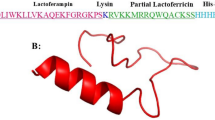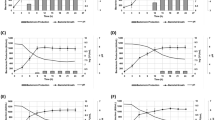Abstract
The antimicrobial activity of CXCL14-C17 and melittin peptides has been confirmed against a broad spectrum of gram-positive and gram-negative bacteria. However, instability and toxicity are two limiting factors for these peptides. This study was aimed to design a novel truncated hybrid peptide with high stability and low toxicity through fusion between mutant analogs of melittin and CXCL14-C17. In this study, melittin(M) and CXCL14-C17-a2(C) peptides were used as a template to design new antimicrobial peptide analogs by Cell PPD server. CAMPR3, ProtParam/ExPASy examined physicochemical properties of peptide analogs. MD simulation analysis was done to evaluate stability and interaction of peptide analogs alone and in contact with model DPPC membrane. A substitution at position 6 of melittin (Ile to Arg) and two substitutions in 11th positions (Tyr to Lys) and 17th (Asn to Arg) of CXCL14-a2 were favored to increase antimicrobial property. A truncated hybrid peptide (TM1C2) was designed to improve the net charge and toxicity. RMSD and RMSF values indicated more stability of the TM1C2 peptide alone and in contact with the DPPC membrane through the hydrophilic side. The order parameter for DPPC membrane in the presence of the hydrophilic side of peptide indicated the disordering effect of the peptide on the arrangement of acyl chains. Based on the COM distance and density profile, TM1C2 peptide displayed more penetration into the membrane through the hydrophilic side. In this study, we developed an attractive procedure for designing a hybrid peptide with higher stability and antimicrobial potential. The TM1C2 peptide with higher antimicrobial and stability has more potential for penetration into the lipid membrane based on physicochemical and MD simulation results.











Similar content being viewed by others
Data availability
The datasets used and/or analyzed during the current study are available from the corresponding author on reasonable request.
Change history
12 June 2023
A Correction to this paper has been published: https://doi.org/10.1007/s11756-023-01452-0
Abbreviations
- AMP:
-
Antimicrobial peptide
- MD:
-
Molecular Dynamic
- MDR:
-
Multidrug-resistant
- D:
-
Discrimination factor
- RMSF:
-
Root-mean-square fluctuations
- RMSD:
-
Root-mean-square deviation
- DPPC:
-
Dipalmitoylphosphatidylcholine membrane
References
Akbari R, Hakemi-Vala M, Pashaie F, Bevalian P, Hashemi A, Pooshang Bagheri K (2019) Highly synergistic effects of melittin with conventional antibiotics against multidrug-resistant isolates of acinetobacter baumannii and pseudomonas aeruginosa. Microb Drug Resist 25(2):193–202. https://doi.org/10.1089/mdr.2018.0016
Asthana N, Yadav SP, Ghosh JK (2004) Dissection of antibacterial and toxic activity of Melittin a leucine zipper motif plays a crucial role in determining its hemolytic activity but not antibacterial activity. J Biol Chem 279(53):55042–55050. https://doi.org/10.1074/jbc.M408881200
Baba MS, Zin NM, Hassan Z, a A, Latip J, Pethick F, Hunter IS, Edrada-Ebel R, Herron PR (2015) In vivo antimalarial activity of the endophytic actinobacteria, Streptomyces SUK 10. J Microbiol 53(12):847–855. https://doi.org/10.1007/s12275-015-5076-6
Blondelle SE, Houghten RA (1991) Hemolytic and antimicrobial activities of the twenty-four individual omission analogs of melittin. Biochem 30(19):4671–4678. https://doi.org/10.1021/bi00233a006
Britt HM, Mosely JA, Sanderson JM (2019) The influence of cholesterol on melittin lipidation in neutral membranes. Phys Chem Chem Phys 21(2):631–640. https://doi.org/10.1039/C8CP06661B
Cassini A, Högberg LD, Plachouras D, Quattrocchi A, Hoxha A, Simonsen GS, Colomb-Cotinat M, Kretzschmar ME, Devleesschauwer B, Cecchini M (2019) Attributable deaths and disability-adjusted life-years caused by infections with antibiotic-resistant bacteria in the EU and the European Economic Area in 2015: a population-level modelling analysis. Lancet Infect Dis 19(1):56–66. https://doi.org/10.1016/S1473-3099(18)30605-4
Cherry MA, Higgins SK, Melroy H, Lee H-S, Pokorny A (2014) Peptides with the same composition, hydrophobicity, and hydrophobic moment bind to phospholipid bilayers with different affinities. J Phys Chem B 118(43):12462–12470. https://doi.org/10.1021/jp507289w
Dimitrov I, Naneva L, Doytchinova I, Bangov I (2014) AllergenFP: allergenicity prediction by descriptor fingerprints. Bioinform 30(6):846–851. https://doi.org/10.1093/bioinformatics/btt619
Doytchinova IA, Flower DR (2007) VaxiJen: a server for prediction of protective antigens, tumour antigens and subunit vaccines. BMC Bioinform 8(1):4. https://doi.org/10.1186/1471-2105-8-4
El Chakhtoura NG, Saade E, Iovleva A, Yasmin M, Wilson B, Perez F, Bonomo RA (2018) Therapies for multidrug resistant and extensively drug-resistant non-fermenting gram-negative bacteria causing nosocomial infections: a perilous journey toward ‘molecularly targeted’therapy. Expert Rev Anti Infect Ther 16(2):89–110. https://doi.org/10.1080/14787210.2018.1425139
Gajski G, Domijan A-M, Žegura B, Štern A, Gerić M, Jovanović IN, Vrhovac I, Madunić J, Breljak D, Filipič M (2016) Melittin induced cytogenetic damage, oxidative stress and changes in gene expression in human peripheral blood lymphocytes. Toxicon 110:56–67. https://doi.org/10.1016/j.toxicon.2015.12.005
Gautam A, Chaudhary K, Kumar R, Raghava GPS (2015) Computer-aided virtual screening and designing of cell-penetrating peptides. In Cell-Penetrating Peptides (pp. 59–69): Springer.
Gautam A, Chaudhary K, Kumar R, Sharma A, Kapoor P, Tyagi A, Raghava GP (2013) In silico approaches for designing highly effective cell penetrating peptides. J Transl Med 11(1):74. https://doi.org/10.1186/1479-5876-11-74
Gautier R, Douguet D, Antonny B, Drin G (2008) HELIQUEST: a web server to screen sequences with specific α-helical properties. Bioinform 24(18):2101–2102. https://doi.org/10.1093/bioinformatics/btn392
Glättli A, Chandrasekhar I, Van Gunsteren WF (2006) A molecular dynamics study of the bee venom melittin in aqueous solution, in methanol, and inserted in a phospholipid bilayer. Eur Biophys J 35(3):255–267. https://doi.org/10.1007/s00249-005-0033-7
Hong J, Lu X, Deng Z, Xiao S, Yuan B, Yang K (2019) How Melittin inserts into cell membrane: Conformational changes, inter-peptide cooperation, and disturbance on the membrane. Molecules 24(9):1775. https://doi.org/10.3390/molecules24091775
Jiang X, Qian K, Liu G, Sun L, Zhou G, Li J, Fang X, Ge H, Lv Z (2019) Design and activity study of a melittin–thanatin hybrid peptide. AMB Express 9(1):14. https://doi.org/10.1186/s13568-019-0739-z
Jiang Z, Vasil AI, Hale JD, Hancock RE, Vasil ML, Hodges RS (2008) Effects of net charge and the number of positively charged residues on the biological activity of amphipathic α-helical cationic antimicrobial peptides. Peptide Sci 90(3):369–383. https://doi.org/10.1002/bip.20911
Kabsch W, Sander C (1983) Dictionary of protein secondary structure: pattern recognition of hydrogen‐bonded and geometrical features. Biopolymers: Original Research on Biomolecules 22(12): 2577–2637. https://doi.org/10.1002/bip.360221211
Kim H, Kim HR, Kim N-R, Jeong BJ, Lee JS, Jang S, Chung DK (2015) Oral administration of Lactobacillus plantarum lysates attenuates the development of atopic dermatitis lesions in mouse models. J Microbiol 53(1):47–52. https://doi.org/10.1007/s12275-015-4483-z
Kim KH, Son JM, Benayoun BA, Lee C (2018) The mitochondrial-encoded peptide MOTS-c translocates to the nucleus to regulate nuclear gene expression in response to metabolic stress. Cell metab 28(3): 516–524. e517. https://doi.org/10.1016/j.cmet.2018.06.008
Li J, Koh J-J, Liu S, Lakshminarayanan R, Verma CS, Beuerman RW (2017) Membrane active antimicrobial peptides: translating mechanistic insights to design. Front Neurosci 11:73. https://doi.org/10.3389/fnins.2017.00073
Maerki C, Meuter S, Liebi M, Mühlemann K, Frederick MJ, Yawalkar N, Moser B, Wolf M (2009) Potent and broad-spectrum antimicrobial activity of CXCL14 suggests an immediate role in skin infections. J Immunol Res 182(1):507–514. https://doi.org/10.4049/jimmunol.182.1.507
Otoda K, Kimura S, Imanishi Y (1992) Interaction of melittin derivatives with lipid bilayer membrane. Role of basic residues at the C-terminal and their replacement with lactose. Biochim Biophys Acta Biomemb 1112(1): 1–6. https://doi.org/10.1016/0005-2736(92)90245-H
Pashaei F, Bevalian P, Akbari R, Bagheri KP (2019) Single dose eradication of extensively drug resistant Acinetobacter spp. in a mouse model of burn infection by melittin antimicrobial peptide. Microb Pathog 127:60–69. https://doi.org/10.1016/j.micpath.2018.11.055
Penk A, Baumann L, Huster D, Samsonov SA (2019) NMR and molecular modeling reveal specificity of the interactions between CXCL14 and glycosaminoglycans. Glycobiology 29(10):715–725. https://doi.org/10.1093/glycob/cwz047
Rahbarnia L, Farajnia S, Khaneshi H, Farajnia H, Naghili B, Tanomand A (2020) Detection of blaOXA-23 and blaNDM-1 carbapenemase among clinical isolates of A. baumannii in Tabriz, north-west of Iran. Gene Reports 18 100555. https://doi.org/10.1016/j.genrep.2019.100555
Rajasekaran G, Kumar SD, Nam J, Jeon D, Kim Y, Lee CW, Park I-S (1861) Shin S Y (2019) Antimicrobial and anti-inflammatory activities of chemokine CXCL14-derived antimicrobial peptide and its analogs. Biochim Biophys Acta Biomemb 1:256–267. https://doi.org/10.1016/j.bbamem.2018.06.016
Rasafar N, Barzegar A, Aghdam EM (2020) Design and development of high affinity dual anticancer peptide-inhibitors against p53-MDM2/X interaction. Life Sci 245:117358. https://doi.org/10.1016/j.lfs.2020.117358
Rivett DE, Kirkpatrick A, Hewish DR, Reilly W, Werkmeister JA (1996) Dimerization of truncated melittin analogues results in cytolytic peptides. Biochem J 316 ( Pt 2)(2): 525–529. Retrieved from https://www.ncbi.nlm.nih.gov/pubmed/8687396. https://doi.org/10.1042/bj3160525
Sun X, Chen S, Li S, Yan H, Fan Y, Mi H (2005) Deletion of two C-terminal Gln residues of 12–26-residue fragment of melittin improves its antimicrobial activity. Peptides 26(3):369–375. https://doi.org/10.1016/j.peptides.2004.10.004
Tsuji K, Shigenaga A, Sumikawa Y, Tanegashima K, Sato K, Aihara K, Hara T, Otaka A (2011) Application of N-C-or C–N-directed sequential native chemical ligation to the preparation of CXCL14 analogs and their biological evaluation. Bioorg Med Chem 19(13):4014–4020. https://doi.org/10.1016/j.bmc.2011.05.018
Wang G, Mishra B, Lau K, Lushnikova T, Golla R, Wang X (2015) Antimicrobial peptides in 2014. Pharmaceuticals 8(1):123–150. https://doi.org/10.3390/ph8010123
Werkmeister JA, Kirkpatrick A, Mckenzie JA, Rivett DE (1993) The effect of sequence variations and structure on the cytolytic activity of melittin peptides. Biochim Biophys Acta Gen Subj 1157(1):50–54. https://doi.org/10.1016/0304-4165(93)90077-L
Wolf M, Moser B (2012) Antimicrobial activities of chemokines: not just a side-effect? Front Immunol 3:213. https://doi.org/10.3389/fimmu.2012.00213
Wu X, Zhao B, Cheng Y, Yang Y, Huang C, Meng X, Wu B, Zhang L, Lv X, Li J (2015) Melittin induces PTCH1 expression by down-regulating MeCP2 in human hepatocellular carcinoma SMMC-7721 cells. Toxicol Appl Pharmacol 288(1):74–83. https://doi.org/10.1016/j.taap.2015.07.010
Zelezetsky I, Tossi A (2006) Alpha-helical antimicrobial peptides—Using a sequence template to guide structure–activity relationship studies. Biochim Biophys Acta Biomembr 1758(9):1436–1449. https://doi.org/10.1016/j.bbamem.2006.03.021
Acknowledgements
This study was supported by the Infectious and Tropical Diseases Research Center, Tabriz University of Medical Sciences, Tabriz, Iran.
Funding
Not applicable.
Author information
Authors and Affiliations
Contributions
S.F. designed the study and revised the manuscript; L.R. performed the data analysis and interpretation. H.Z. wrote the first draft of the manuscript. B.N. discussed the results. All authors read and approved the final manuscript.
Corresponding author
Ethics declarations
Ethics approval
The study was conducted after ethical approval of the ethics committee of Tabriz University of medical science, Tabriz Iran (reference number: IR.TBZMED.VCR. REC. 1397. 388).
Competing interests
The authors have no conflict of interest.
Additional information
Publisher's Note
Springer Nature remains neutral with regard to jurisdictional claims in published maps and institutional affiliations.
Rights and permissions
Springer Nature or its licensor (e.g. a society or other partner) holds exclusive rights to this article under a publishing agreement with the author(s) or other rightsholder(s); author self-archiving of the accepted manuscript version of this article is solely governed by the terms of such publishing agreement and applicable law.
About this article
Cite this article
Farajnia, S., Rahbarnia, L., Khajehnasiri, N. et al. Design of a hybrid peptide derived from Melittin and CXCL14 –C17: A molecular dynamics simulation study. Biologia 77, 2269–2280 (2022). https://doi.org/10.1007/s11756-022-01067-x
Received:
Accepted:
Published:
Issue Date:
DOI: https://doi.org/10.1007/s11756-022-01067-x




